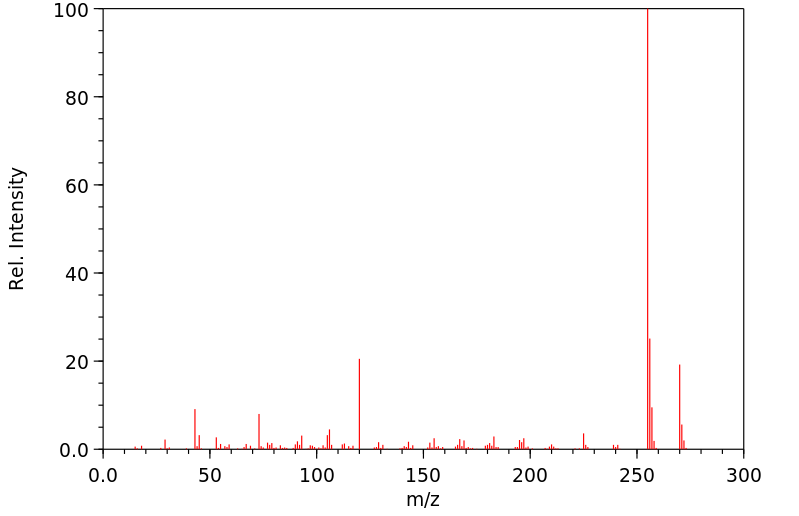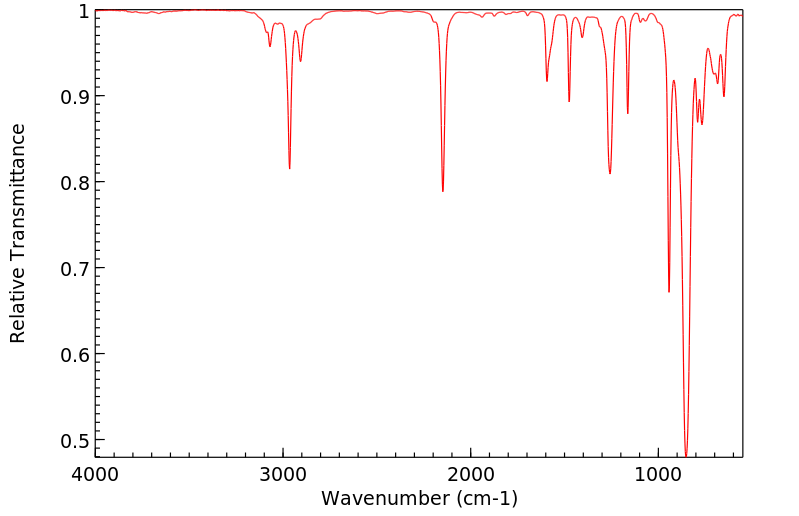1,3-双[(三甲基硅甲基)乙炔基]苯 | 38170-80-8
中文名称
1,3-双[(三甲基硅甲基)乙炔基]苯
中文别名
1,3-双[(三甲基硅基)乙炔基]苯;1,3-二[(三甲基硅基)乙炔基]苯
英文名称
1,3-di(trimethylsilylethynyl)benzene
英文别名
1,3-bis((trimethylsilyl)ethynyl)benzene;trimethyl-[2-[3-(2-trimethylsilylethynyl)phenyl]ethynyl]silane
CAS
38170-80-8
化学式
C16H22Si2
mdl
——
分子量
270.522
InChiKey
ASZOZZMGMNVKDV-UHFFFAOYSA-N
BEILSTEIN
——
EINECS
——
-
物化性质
-
计算性质
-
ADMET
-
安全信息
-
SDS
-
制备方法与用途
-
上下游信息
-
文献信息
-
表征谱图
-
同类化合物
-
相关功能分类
-
相关结构分类
物化性质
-
熔点:57 °C
-
沸点:304.9±38.0 °C(Predicted)
-
密度:0.92±0.1 g/cm3(Predicted)
-
溶解度:溶于甲苯
-
稳定性/保质期:
常规情况下不会分解,没有危险反应。
计算性质
-
辛醇/水分配系数(LogP):4.14
-
重原子数:18
-
可旋转键数:4
-
环数:1.0
-
sp3杂化的碳原子比例:0.38
-
拓扑面积:0
-
氢给体数:0
-
氢受体数:0
安全信息
-
TSCA:No
-
安全说明:S26,S36
-
危险类别码:R36/37/38
-
海关编码:2931900090
-
危险性防范说明:P261,P280,P301+P312,P302+P352,P305+P351+P338
-
危险性描述:H302,H315,H319,H335
SDS
1,3-双[(三甲基硅基)乙炔基]苯 修改号码:5
模块 1. 化学品
产品名称: 1,3-Bis[(trimethylsilyl)ethynyl]benzene
修改号码: 5
模块 2. 危险性概述
GHS分类
物理性危害 未分类
健康危害 未分类
环境危害 未分类
GHS标签元素
图标或危害标志 无
信号词 无信号词
危险描述 无
防范说明 无
模块 3. 成分/组成信息
单一物质/混和物 单一物质
化学名(中文名): 1,3-双[(三甲基硅基)乙炔基]苯
百分比: >98.0%(GC)
CAS编码: 38170-80-8
分子式: C16H22Si2
模块 4. 急救措施
吸入: 将受害者移到新鲜空气处,保持呼吸通畅,休息。若感不适请求医/就诊。
皮肤接触: 立即去除/脱掉所有被污染的衣物。用水清洗皮肤/淋浴。
若皮肤刺激或发生皮疹:求医/就诊。
眼睛接触: 用水小心清洗几分钟。如果方便,易操作,摘除隐形眼镜。继续清洗。
如果眼睛刺激:求医/就诊。
食入: 若感不适,求医/就诊。漱口。
紧急救助者的防护: 救援者需要穿戴个人防护用品,比如橡胶手套和气密性护目镜。
模块 5. 消防措施
合适的灭火剂: 干粉,泡沫,雾状水,二氧化碳
特殊危险性: 小心,燃烧或高温下可能分解产生毒烟。
1,3-双[(三甲基硅基)乙炔基]苯 修改号码:5
模块 5. 消防措施
特定方法: 从上风处灭火,根据周围环境选择合适的灭火方法。
非相关人员应该撤离至安全地方。
周围一旦着火:如果安全,移去可移动容器。
消防员的特殊防护用具: 灭火时,一定要穿戴个人防护用品。
模块 6. 泄漏应急处理
个人防护措施,防护用具, 使用个人防护用品。远离溢出物/泄露处并处在上风处。
紧急措施: 泄露区应该用安全带等圈起来,控制非相关人员进入。
环保措施: 防止进入下水道。
控制和清洗的方法和材料: 清扫收集粉尘,封入密闭容器。注意切勿分散。附着物或收集物应该立即根据合适的
法律法规处置。
模块 7. 操作处置与储存
处理
技术措施: 在通风良好处进行处理。穿戴合适的防护用具。防止粉尘扩散。处理后彻底清洗双手
和脸。
注意事项: 如果粉尘或浮质产生,使用局部排气。
操作处置注意事项: 避免接触皮肤、眼睛和衣物。
贮存
储存条件: 保持容器密闭。冷藏储存。
存放于惰性气体环境中。
防湿。
远离不相容的材料比如氧化剂存放。
热敏, 潮敏, 气敏
包装材料: 依据法律。
模块 8. 接触控制和个体防护
工程控制: 尽可能安装封闭体系或局部排风系统,操作人员切勿直接接触。同时安装淋浴器和洗
眼器。
个人防护用品
呼吸系统防护: 防尘面具。依据当地和政府法规。
手部防护: 防护手套。
眼睛防护: 安全防护镜。如果情况需要,佩戴面具。
皮肤和身体防护: 防护服。如果情况需要,穿戴防护靴。
模块 9. 理化特性
固体
外形(20°C):
外观: 晶体-粉末
颜色: 白色-极淡的黄色
气味: 无资料
pH: 无数据资料
熔点:
60°C
沸点/沸程 无资料
闪点: 无资料
爆炸特性
爆炸下限: 无资料
爆炸上限: 无资料
密度: 无资料
溶解度:
1,3-双[(三甲基硅基)乙炔基]苯 修改号码:5
模块 9. 理化特性
[水] 无资料
[其他溶剂]
溶于: 甲苯
模块 10. 稳定性和反应性
化学稳定性: 一般情况下稳定。
危险反应的可能性: 未报道特殊反应性。
须避免接触的物质 氧化剂
危险的分解产物: 一氧化碳, 二氧化碳, 氧化硅
模块 11. 毒理学信息
急性毒性: 无资料
对皮肤腐蚀或刺激: 无资料
对眼睛严重损害或刺激: 无资料
生殖细胞变异原性: 无资料
致癌性:
IARC = 无资料
NTP = 无资料
生殖毒性: 无资料
模块 12. 生态学信息
生态毒性:
鱼类: 无资料
甲壳类: 无资料
藻类: 无资料
残留性 / 降解性: 无资料
潜在生物累积 (BCF): 无资料
土壤中移动性
log水分配系数: 无资料
土壤吸收系数 (Koc): 无资料
亨利定律 无资料
constaNT(PaM3/mol):
模块 13. 废弃处置
如果可能,回收处理。请咨询当地管理部门。建议在可燃溶剂中溶解混合,在装有后燃和洗涤装置的化学焚烧炉中
焚烧。废弃处置时请遵守国家、地区和当地的所有法规。
模块 14. 运输信息
联合国分类: 与联合国分类标准不一致
UN编号: 未列明
模块 15. 法规信息
《危险化学品安全管理条例》(2002年1月26日国务院发布,2011年2月16日修订): 针对危险化学品的安全使用、
生产、储存、运输、装卸等方面均作了相应的规定。
1,3-双[(三甲基硅基)乙炔基]苯 修改号码:5
模块16 - 其他信息
N/A
模块 1. 化学品
产品名称: 1,3-Bis[(trimethylsilyl)ethynyl]benzene
修改号码: 5
模块 2. 危险性概述
GHS分类
物理性危害 未分类
健康危害 未分类
环境危害 未分类
GHS标签元素
图标或危害标志 无
信号词 无信号词
危险描述 无
防范说明 无
模块 3. 成分/组成信息
单一物质/混和物 单一物质
化学名(中文名): 1,3-双[(三甲基硅基)乙炔基]苯
百分比: >98.0%(GC)
CAS编码: 38170-80-8
分子式: C16H22Si2
模块 4. 急救措施
吸入: 将受害者移到新鲜空气处,保持呼吸通畅,休息。若感不适请求医/就诊。
皮肤接触: 立即去除/脱掉所有被污染的衣物。用水清洗皮肤/淋浴。
若皮肤刺激或发生皮疹:求医/就诊。
眼睛接触: 用水小心清洗几分钟。如果方便,易操作,摘除隐形眼镜。继续清洗。
如果眼睛刺激:求医/就诊。
食入: 若感不适,求医/就诊。漱口。
紧急救助者的防护: 救援者需要穿戴个人防护用品,比如橡胶手套和气密性护目镜。
模块 5. 消防措施
合适的灭火剂: 干粉,泡沫,雾状水,二氧化碳
特殊危险性: 小心,燃烧或高温下可能分解产生毒烟。
1,3-双[(三甲基硅基)乙炔基]苯 修改号码:5
模块 5. 消防措施
特定方法: 从上风处灭火,根据周围环境选择合适的灭火方法。
非相关人员应该撤离至安全地方。
周围一旦着火:如果安全,移去可移动容器。
消防员的特殊防护用具: 灭火时,一定要穿戴个人防护用品。
模块 6. 泄漏应急处理
个人防护措施,防护用具, 使用个人防护用品。远离溢出物/泄露处并处在上风处。
紧急措施: 泄露区应该用安全带等圈起来,控制非相关人员进入。
环保措施: 防止进入下水道。
控制和清洗的方法和材料: 清扫收集粉尘,封入密闭容器。注意切勿分散。附着物或收集物应该立即根据合适的
法律法规处置。
模块 7. 操作处置与储存
处理
技术措施: 在通风良好处进行处理。穿戴合适的防护用具。防止粉尘扩散。处理后彻底清洗双手
和脸。
注意事项: 如果粉尘或浮质产生,使用局部排气。
操作处置注意事项: 避免接触皮肤、眼睛和衣物。
贮存
储存条件: 保持容器密闭。冷藏储存。
存放于惰性气体环境中。
防湿。
远离不相容的材料比如氧化剂存放。
热敏, 潮敏, 气敏
包装材料: 依据法律。
模块 8. 接触控制和个体防护
工程控制: 尽可能安装封闭体系或局部排风系统,操作人员切勿直接接触。同时安装淋浴器和洗
眼器。
个人防护用品
呼吸系统防护: 防尘面具。依据当地和政府法规。
手部防护: 防护手套。
眼睛防护: 安全防护镜。如果情况需要,佩戴面具。
皮肤和身体防护: 防护服。如果情况需要,穿戴防护靴。
模块 9. 理化特性
固体
外形(20°C):
外观: 晶体-粉末
颜色: 白色-极淡的黄色
气味: 无资料
pH: 无数据资料
熔点:
60°C
沸点/沸程 无资料
闪点: 无资料
爆炸特性
爆炸下限: 无资料
爆炸上限: 无资料
密度: 无资料
溶解度:
1,3-双[(三甲基硅基)乙炔基]苯 修改号码:5
模块 9. 理化特性
[水] 无资料
[其他溶剂]
溶于: 甲苯
模块 10. 稳定性和反应性
化学稳定性: 一般情况下稳定。
危险反应的可能性: 未报道特殊反应性。
须避免接触的物质 氧化剂
危险的分解产物: 一氧化碳, 二氧化碳, 氧化硅
模块 11. 毒理学信息
急性毒性: 无资料
对皮肤腐蚀或刺激: 无资料
对眼睛严重损害或刺激: 无资料
生殖细胞变异原性: 无资料
致癌性:
IARC = 无资料
NTP = 无资料
生殖毒性: 无资料
模块 12. 生态学信息
生态毒性:
鱼类: 无资料
甲壳类: 无资料
藻类: 无资料
残留性 / 降解性: 无资料
潜在生物累积 (BCF): 无资料
土壤中移动性
log水分配系数: 无资料
土壤吸收系数 (Koc): 无资料
亨利定律 无资料
constaNT(PaM3/mol):
模块 13. 废弃处置
如果可能,回收处理。请咨询当地管理部门。建议在可燃溶剂中溶解混合,在装有后燃和洗涤装置的化学焚烧炉中
焚烧。废弃处置时请遵守国家、地区和当地的所有法规。
模块 14. 运输信息
联合国分类: 与联合国分类标准不一致
UN编号: 未列明
模块 15. 法规信息
《危险化学品安全管理条例》(2002年1月26日国务院发布,2011年2月16日修订): 针对危险化学品的安全使用、
生产、储存、运输、装卸等方面均作了相应的规定。
1,3-双[(三甲基硅基)乙炔基]苯 修改号码:5
模块16 - 其他信息
N/A
上下游信息
反应信息
-
作为反应物:描述:1,3-双[(三甲基硅甲基)乙炔基]苯 在 sodium hydroxide 作用下, 生成 1,3-二乙炔苯参考文献:名称:手性三唑基卤素键供体的合成摘要:抽象的 在自组装,超分子聚集和催化领域中使用卤素键的应用数量正在增长。但是,手性卤代三唑的可及性表明,还有很多值得探索的地方。简单的点击化学可用于对映体纯的单和双齿以及多功能基于碘三唑的XB供体的直接合成。该方法的特点是由于容易获得手性叠氮化物而具有广泛的可变性。 在自组装,超分子聚集和催化领域中使用卤素键的应用数量正在增长。但是,手性卤代三唑的可及性表明,还有很多值得探索的地方。简单的点击化学可用于对映体纯的单和双齿以及多功能基于碘三唑的XB供体的直接合成。该方法的特点是由于容易获得手性叠氮化物而具有广泛的可变性。DOI:10.1055/s-0037-1610864
-
作为产物:描述:参考文献:名称:Synthesis of a bifunctional boron-Lewis acid and studies on host-guest chemistry using pyridine and TMPD摘要:基于先前描述的具有硼功能距离为4.918(2) Å的双功能Lewis酸,展示了开发具有更宽功能距离的双功能、含硼Lewis酸的进展。再次使用了一种含锡前体,并通过锡-硼交换引入了Lewis酸性硼功能团。通过NMR实验和使用吡啶和TMPD(N1,N1,N4,N4-四甲基苯-1,4-二胺)作为Lewis碱性客体的固态结构,展示了这类化合物用于形成宿主-客体复合物的一般适用性。通过分解产物的结构阐明,研究了微量水分对含硼双功能Lewis酸的影响。DOI:10.1515/znb-2021-0175
-
作为试剂:描述:1,3-二乙炔苯 在 1,3-双[(三甲基硅甲基)乙炔基]苯 bis-triphenylphosphine-palladium(II) chloride 、 copper(l) iodide 、 Merrifield's resin-immobilized (3,4-dihydropyran-2-yl)CH2OH 、 potassium carbonate 、 对甲苯磺酸 、 N,N-二异丙基乙胺 作用下, 以 四氢呋喃 、 甲醇 、 二氯甲烷 、 1,2-二氯乙烷 为溶剂, 反应 135.0h, 生成 Methyl 3-[2-[3-[2-[3-(hydroxymethyl)-5-iodophenyl]ethynyl]phenyl]ethynyl]-5-[2-[3-[2-[3-[2-[3-[2-[3-(hydroxymethyl)-5-iodophenyl]ethynyl]phenyl]ethynyl]-5-methoxycarbonylphenyl]ethynyl]phenyl]ethynyl]benzoate参考文献:名称:Solid-phase approaches toward cyclic oligomers摘要:Strategies were sought to effect cyclizations of oligo(m-phenylene ethynylene) by exploiting pseudo-high dilution effects on polymer supports. Using Pd/Cu-catalyzed coupling protocols, Merrifield's resin (1% crosslinked chloromethylated polystyrene) proved inadequate for site isolation; inter-site couplings ensued on the flexible support. Conversely, use of the Argopore resin, a more highly crosslinked polystyrene, inhibited inter-site interactions, and no identifiable final product could be separated from the resin. Spectroscopic and mass spectrometric methods indicated that the product from the Argopore resin might be a threaded catenane. (C) 2001 Elsevier Science Ltd. All rights reserved.DOI:10.1016/s0040-4020(01)00930-9
文献信息
-
Reaction between Azidyl Radicals and Alkynes: A Straightforward Approach to<i>NH</i>-1,2,3-Triazoles作者:Long Hu、Christian Mück-Lichtenfeld、Tao Wang、Guifeng He、Meng Gao、Junfeng ZhaoDOI:10.1002/chem.201504515日期:2016.1.18Reaction between nitrogen‐centered radicals and unsaturated C−C bonds is an effective synthetic strategy for the construction of nitrogen‐containing molecules. Although the reactions between nitrogen‐centered radicals and alkenes have been studied extensively, their counterpart reactions with alkynes are extremely rare. Herein, the first example of reactions between azidyl radicals and alkynes is described
-
Aerobic Oxynitration of Alkynes with <sup><i>t</i></sup>BuONO and TEMPO作者:Uttam Dutta、Soham Maity、Rajesh Kancherla、Debabrata MaitiDOI:10.1021/ol503025n日期:2014.12.19An efficient method for stereoselective nitroaminoxylation of alkyne has been reported. The reaction enjoys a broad substrate scope, good functional group tolerance, and high yields. Synthetically useful α-nitroketones can be accessed through these products in a single step.已经报道了炔的立体选择性硝基氨基羟化的有效方法。该反应具有广泛的底物范围,良好的官能团耐受性和高产率。合成有用的α-硝基酮可以一步一步地通过这些产品获得。
-
Cys–Cys and Cys–Lys Stapling of Unprotected Peptides Enabled by Hypervalent Iodine Reagents作者:Javier Ceballos、Elija Grinhagena、Gontran Sangouard、Christian Heinis、Jerome WaserDOI:10.1002/anie.202014511日期:2021.4.12Easy access to a wide range of structurally diverse stapled peptides is crucial for the development of inhibitors of protein‐protein interactions. Herein, we report bis‐functional hypervalent iodine reagents for two‐component cysteine‐cysteine and cysteine‐lysine stapling yielding structurally diverse thioalkyne linkers. This stapling method works with unprotected natural amino acid residues and does
-
Ph2P(O) Group for Protection of Terminal Acetylenes作者:Akihiro Orita、Junzo Otera、Xin Yang、Daisuke Matsuo、Yoshinori Suzuma、Jing-Kun Fang、Feng Xu、Shingo Kajiyama、Nagatoshi Koumura、Kohjiro HaraDOI:10.1055/s-0030-1261223日期:2011.10A protecting group Ph2P(O) for terminal ethyne was newly developed. This protecting group can be introduced readily to terminal ethyne by CuI-catalyzed phosphination and subsequent oxidation with H2O2. Ph2P(O)-protected ethynes remained intact in Sonogashira coupling, and their high polarity enabled easy separation of the desired coupling product from by-products. By treatment with t-BuOK, Ph2P(O)-protected
-
Synthesis of chiral 1,3-bis(1-(diarylphosphoryl)ethyl)-benzenes via Ir-catalyzed double asymmetric hydrogenation of bis(diarylvinylphosphine oxides)作者:Xu Liu、ZhaoBin Han、Zheng Wang、KuiLing DingDOI:10.1007/s11426-014-5134-7日期:2014.8A class of chiral 1,3-bis(diarylphosphinoethyl)benzenes, which are key intermediates for the synthesis of PCP-type chiral pincer ligands, were prepared in high diastereomeric ratios and excellent ee values via double asymmetric hydrogenation of the corresponding bis(diarylvinylphosphine oxide) substrates using a SpinPhox/Ir(I) complex as the catalyst. The hydrogenation product 5a was readily transformed
表征谱图
-
氢谱1HNMR
-
质谱MS
-
碳谱13CNMR
-
红外IR
-
拉曼Raman
-
峰位数据
-
峰位匹配
-
表征信息
同类化合物
(βS)-β-氨基-4-(4-羟基苯氧基)-3,5-二碘苯甲丙醇
(S,S)-邻甲苯基-DIPAMP
(S)-(-)-7'-〔4(S)-(苄基)恶唑-2-基]-7-二(3,5-二-叔丁基苯基)膦基-2,2',3,3'-四氢-1,1-螺二氢茚
(S)-盐酸沙丁胺醇
(S)-3-(叔丁基)-4-(2,6-二甲氧基苯基)-2,3-二氢苯并[d][1,3]氧磷杂环戊二烯
(S)-2,2'-双[双(3,5-三氟甲基苯基)膦基]-4,4',6,6'-四甲氧基联苯
(S)-1-[3,5-双(三氟甲基)苯基]-3-[1-(二甲基氨基)-3-甲基丁烷-2-基]硫脲
(R)富马酸托特罗定
(R)-(-)-盐酸尼古地平
(R)-(-)-4,12-双(二苯基膦基)[2.2]对环芳烷(1,5环辛二烯)铑(I)四氟硼酸盐
(R)-(+)-7-双(3,5-二叔丁基苯基)膦基7''-[((6-甲基吡啶-2-基甲基)氨基]-2,2'',3,3''-四氢-1,1''-螺双茚满
(R)-(+)-7-双(3,5-二叔丁基苯基)膦基7''-[(4-叔丁基吡啶-2-基甲基)氨基]-2,2'',3,3''-四氢-1,1''-螺双茚满
(R)-(+)-7-双(3,5-二叔丁基苯基)膦基7''-[(3-甲基吡啶-2-基甲基)氨基]-2,2'',3,3''-四氢-1,1''-螺双茚满
(R)-(+)-4,7-双(3,5-二-叔丁基苯基)膦基-7“-[(吡啶-2-基甲基)氨基]-2,2”,3,3'-四氢1,1'-螺二茚满
(R)-3-(叔丁基)-4-(2,6-二苯氧基苯基)-2,3-二氢苯并[d][1,3]氧杂磷杂环戊烯
(R)-2-[((二苯基膦基)甲基]吡咯烷
(R)-1-[3,5-双(三氟甲基)苯基]-3-[1-(二甲基氨基)-3-甲基丁烷-2-基]硫脲
(N-(4-甲氧基苯基)-N-甲基-3-(1-哌啶基)丙-2-烯酰胺)
(5-溴-2-羟基苯基)-4-氯苯甲酮
(5-溴-2-氯苯基)(4-羟基苯基)甲酮
(5-氧代-3-苯基-2,5-二氢-1,2,3,4-oxatriazol-3-鎓)
(4S,5R)-4-甲基-5-苯基-1,2,3-氧代噻唑烷-2,2-二氧化物-3-羧酸叔丁酯
(4S,4''S)-2,2''-亚环戊基双[4,5-二氢-4-(苯甲基)恶唑]
(4-溴苯基)-[2-氟-4-[6-[甲基(丙-2-烯基)氨基]己氧基]苯基]甲酮
(4-丁氧基苯甲基)三苯基溴化磷
(3aR,8aR)-(-)-4,4,8,8-四(3,5-二甲基苯基)四氢-2,2-二甲基-6-苯基-1,3-二氧戊环[4,5-e]二恶唑磷
(3aR,6aS)-5-氧代六氢环戊基[c]吡咯-2(1H)-羧酸酯
(2Z)-3-[[(4-氯苯基)氨基]-2-氰基丙烯酸乙酯
(2S,3S,5S)-5-(叔丁氧基甲酰氨基)-2-(N-5-噻唑基-甲氧羰基)氨基-1,6-二苯基-3-羟基己烷
(2S,2''S,3S,3''S)-3,3''-二叔丁基-4,4''-双(2,6-二甲氧基苯基)-2,2'',3,3''-四氢-2,2''-联苯并[d][1,3]氧杂磷杂戊环
(2S)-(-)-2-{[[[[3,5-双(氟代甲基)苯基]氨基]硫代甲基]氨基}-N-(二苯基甲基)-N,3,3-三甲基丁酰胺
(2S)-2-[[[[[((1S,2S)-2-氨基环己基]氨基]硫代甲基]氨基]-N-(二苯甲基)-N,3,3-三甲基丁酰胺
(2S)-2-[[[[[[((1R,2R)-2-氨基环己基]氨基]硫代甲基]氨基]-N-(二苯甲基)-N,3,3-三甲基丁酰胺
(2-硝基苯基)磷酸三酰胺
(2,6-二氯苯基)乙酰氯
(2,3-二甲氧基-5-甲基苯基)硼酸
(1S,2S,3S,5S)-5-叠氮基-3-(苯基甲氧基)-2-[(苯基甲氧基)甲基]环戊醇
(1S,2S,3R,5R)-2-(苄氧基)甲基-6-氧杂双环[3.1.0]己-3-醇
(1-(4-氟苯基)环丙基)甲胺盐酸盐
(1-(3-溴苯基)环丁基)甲胺盐酸盐
(1-(2-氯苯基)环丁基)甲胺盐酸盐
(1-(2-氟苯基)环丙基)甲胺盐酸盐
(1-(2,6-二氟苯基)环丙基)甲胺盐酸盐
(-)-去甲基西布曲明
龙蒿油
龙胆酸钠
龙胆酸叔丁酯
龙胆酸
龙胆紫-d6
龙胆紫








